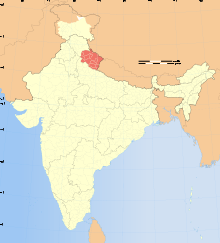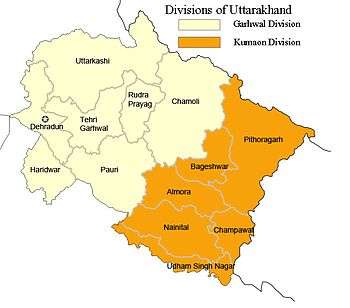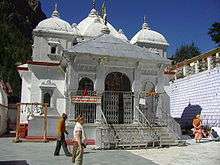Garhwali people
| Regions with significant populations | |
|---|---|
| Languages | |
| Garhwali language | |
| Religion | |
|
|
Garhwali people are an ethno-linguistic group who primarily live in the Garhwal Himalayas of the northern Indian state of Uttarakhand. Any person who has ancestral Garhwali roots or lives in Garhwal and has a Garhwali heritage is called a Garhwali.
They include all those who speak the Garhwali language or any of its numerous dialects, living in Dehradun, Haridwar, Tehri Garhwal, Pauri Garhwal, Uttarkashi, Chamoli and Rudraprayag districts of Uttarakhand, India.
There is documented evidence that the Garhwal region has been inhabited by the mankind at least since the Vedic period, and the people of Garhwal today are the descendants of different waves of migration of Indo-Aryan people to these hills which took place over several centuries.
Significant communities of Garhwalis are present in the surrounding Indian states of Uttar Pradesh, Himachal Pradesh, Haryana, Delhi, Punjab, Madhya Pradesh, Rajasthan and Maharashtra along with a sizable population overseas. According to various estimates, there are at least 2.5 million Garhwali migrants living in Delhi and the National Capital Region.
Garhwal Kingdom



The Kingdom of Garhwal was founded by Panwar/Parmaar Rajputs nearly 700 years ago at a place called Chandpur Garhi. Earlier Garhwal used to have 52 principalities called Garhs(cluster of habitations). Garh was ruled by a Chief, one of these chiefs, Ajai Pal ruler of Chandpur Garhi from Panwar dynasty, reduced all the minor principalities under his own sway with the power of his sword, and founded the Garhwal Kingdom. He and his descendants ruled over Garhwal in an uninterrupted line till 1803, when the Gurkhas invaded Kumaon and Garhwal, driving the Garhwal chief into the plains. For twelve years the Gurkhas ruled the country with a rod of iron, until a series of encroachments by them on British territory led to the Anglo–Nepalese War in 1814. At the termination of the campaign, Garhwal Kingdom and Kumaon Kingdom were converted into British districts, while the Tehri principality was restored to a son of deceased king Pradyumn Shah, King Sudarshan Shah. Another part taken by British was called British Garhwal and had an area of 5,629 mi2 (14,580 km2). Garhwal rapidly advanced in material prosperity. Two battalions of the Indian army (the 39th Garhwal Rifles) were recruited in the district, which also contained the military cantonment of Lansdowne. Grain and coarse cloth were exported, and salt, borax, livestock and wool were imported, and the trade with Tibet was considerable. The administrative headquarters were at Pauri, but Srinagar(Garhwal) was the largest city. It was an important mart, as was Kotdwara -the terminus of a branch of the Oudh and Rohilkhand railway from Najibabad. Later it was part of the Punjab Hill States Agency of British India, consisting of the present day Tehri Garhwal district and most of the Uttarkashi district and acceded to the Union of India in 1949. Garhwal is a holy place of India.
Language
The Garhwali language: It is primarily spoken by the Garhwali people who are from the north-western Garhwal Division of the northern state of Uttarakhand in the Indian Himalayas. uttarakhandi languages include Garhwali and Kumauni (spoken in the Kumaun region of Uttrakhand). Garhwali, like Kumauni, has many regional dialects spoken in different places in Uttarakhand. Garhwali is one of the 325 recognised languages of India, spoken by over 2,667,314 people in Tehri Garhwal, Pauri Garhwal, Uttarkashi, Chamoli, Dehradun, and Rudraprayag districts of Uttarakhand. However, due to a number of reasons, Garhwali is one of the languages which is shrinking very rapidly. UNESCO's Atlas of the World's Languages in Danger designates Garhwali as a language which is in the unsafe category and requires consistent conservation efforts. Garhwali was the official language of the Kingdom of Garhwal since 8th century. Any person who has ancestral Garhwali roots or lives in Garhwal and has a Garhwali heritage is called a Garhwali. They include all those who speak the Garhwali language or any of its numerous dialects. Garhwali people are divided into two castes- Garhwali Brahmin, & Garhwali Rajput. The later Aryans with their languages helped in adding to the vocabulary & had considerable influence in shaping the Garhwali Language. Garhwal was always a sovereign nation under the Garhwali Kings. Naturally, Garhwali was the official language of the Garhwal Kingdom for hundreds of years under the Panwar (Shah) Kings and even before them, until the Gurkhas captured Garhwal and subsequently the British occupied of Garhwal, later called British Garhwal.
The Garhwali language (गढ़वळि भाख/भासा) is a Central Pahari language belonging to the Northern Zone of Indo-Aryan languages and is native to Garhwal. Garhwali like other languages changed a lot with the course of time. Ancient Garhwali was close to Sanskrit being a dialect of it and which was later influenced by Prakrit and the famous Saursheni apabhrasha of Hindi. So it can be said that the Garhwali language developed from or is a mixed form of the following languages:
- Sanskritvedic/Puranic and Lokik)
- Pali/Prakrit
- Hindi(Saurseni Apabhrasha)
Garhwali is one of the 325 recognised languages of India[1] spoken by over 2,267,314[2] people in Tehri Garhwal, Pauri Garhwal, Uttarkashi, Chamoli, Dehradun, Haridwar and Rudraprayag districts of Uttarakhand.[3] Garhwali is also spoken by people in other parts of India including Himachal Pradesh, Delhi, Haryana, Punjab, Uttar Pradesh and Bihar, the official language of India. However, due to a number of reasons, Garhwali is one of the languages which is shrinking very rapidly. UNESCO's Atlas of the World's Languages in Danger designates Garhwali as a language which is in the unsafe category and requires consistent conservation efforts.[4]
Local deities
Chandrabadni Devi Temple: this place is in Tehri garhwal and one can reach the temple either from Kandikhal en route Srinagar-Tehri, from where it is an 8 km walk to the temple or from Jamnikhal en route Dev Prayag-Tehri via a link road up to Jurana (9 km) and then take a bridle path (1.5 km) up to the temple. A big fair is held in April every year. Adding to the various religious and culture performances, the view of the snowcapped Himalayas is soul lifting. A visit to the shrine is an experience to cherish.[5]
| Rudraprayag | |
|---|---|
 |
|
| Umra Narayan | Koteshwar Mahadev |
 |
 |
| Dhari Devi (Uttarakhand) | Kalimath |
| Template:Rudraprayag/srinagar temples | |
Umra Narayan : placed between the mystic and peaceful hills of Rudraprayag lies the Devine temple of Lord Umra Narayan (Isth Dev of gram sann). According to mythology this temple was built during the time of Adi Shankracharya and it is believed that it was built by his holiness Adi Shankracharya when he was on his way to Lord Badrinath's temple. The temple now has been renovated and is 5–7 km away from the main city of Rudraprayag with Maa Alaknanda flowing tranquily nearby. It is also believed that most of the Isth Devas of Garhwal regions are incarnations of Lord Vishnu (Narsingh dev ji) or sometimes Vishnu itself.
| Umra Narayan | |||
|---|---|---|---|
Koteshwar Mahadev is located about three km inside the 'heart' of Rudraprayag, kuteshwar/Koteshwar Mahadev Temple is dedicated to Lord Shiva. This place is presumed to be the same spot where Lord Shiva had stopped for meditation on his way to Kedarnath. According to a local mythology this temple has its presence since the time of bhasmasur (the Deadly Asur/demon who got a boon/vardan from lord Shiva that whosoever's head will be touched by him, will be turned into bhasma or ashes .Seeing the powerful effects of this boon he tried to bhasam lord Shiva Lord Shiva kept on hiding from place to place and finally came to this place which was a cave, lord Shiva resided here for some time meditating lord Vishnu and finally lord Vishnu helped him by killing the demon. The temple is filled with amazing energy/aura and one can feel it. Few drops of water keeps on dropping in lords lingam seeping through the hill. Just a few metres down lies Alaknanda river only whose water is poured down the lords lingam with chants of "OM NAMAH SHIVAY"
Dhari Devi (Uttarakhand) :The temple of Dhari Devi is situated on the banks of the river Alaknanda. One has to travel 15 km. from Srinagar (Pauri Garhwal) on Srinagar-Badrinath highway to Kaliya Saur, then trek down another half a kilometre towards Alaknanda river. The upper part of Goddess Kali is worshipped here and the remaining part in Kalimath. As opinion of villagers the face of the idol changes as a girl, a woman and an old lady as the progress of time. This idol is in the open. Many times villagers and some philanthropists have tried to build a roof for Maa, but every time it has been destroyed. Local myths say that Maa Likes to shower her blessings in the open. As per Srimad Devi Bhagwat there are 108 shakti peethas in India and this holy shrine is one of them.
Kalimath: Kalimath (originally known, and still sometimes referred to, as Kaviltha) is a village which is regarded as a divine place and shakti peeth. It lies at an altitude of around 6,000 feet (1,800 m) on the river Saraswati in the Himalayas, surrounded by the peaks of Kedarnath in Rudraprayag District of Uttarakhand, India. Kalimath is situated close to Ukhimath, and Guptakashi. It is one of the "Siddha Peeths" of the region and is held in high religious esteem. The temple of Goddess Kali located here is visited by a large number of devotees round the year and specially during the "Navratras". There are 108 Shakti Peethas in India and this holy shrine is one of them as per Srimad Devi Bhagwat. The upper part of Goddess Kali is worshipped in Dhari Devi(Uttarakhand) and the remaining part in Kalimath Religious tradition is that Kalimath is where Kali killed the demon Raktavija and had gone under the earth. Kalimath is only the place where goddess Kali is worshipped along with her sisters Laxmi and Saraswati. There is a temple of the goddess Kali, which is visited by a large number of devotees throughout the year, and especially during the Navratras. A peculiar thing about the temple is that there is no idol that is worshipped here, instead, the Sri Yantra, is the object of devotion. On one day each year the goddess is taken out and Puja is performed at midnight, with only the chief priest present. The temple is other ancient temples to Laxmi, Saraswati, Gauri Shankar and many antique Shivlings, idols of Nandi, Ganesh etc. An eternal holy flame always burns in the temple of Laxmi. Bhairava Mandir is also located very near. Barti Baba is credited for preserving the sanctity of this holy shrine.All the people who met him and the locals say that he had direct connection with Maa Kali. The guru and Member of Parliament, Satpal Maharaj, has set up a small Dharamshala very close to the temple. Pilgrims can stay there. The village is the birthplace of Kalidas, a Sanskrit poet.
See also
References
- ↑ "India languages". We make learning fun. Hindikids. Retrieved 14 May 2013.
- ↑ "Sensus Data Online http://www.censusindia.gov.in/Census_Data_2001/Census_Data_Online/Language/Statement1.htm.". We make learning fun. Hindikids. Retrieved 14 May 2013. External link in
|title=(help) - ↑ Claus-Peter Zoller (March 1997). "Garhwali. A language of India". Ethnologue. Retrieved 14 May 2013.
- ↑ "UNESCO Interactive Atlas of the World's Languages in Danger". UNESCO. Retrieved 14 May 2013. Search 'Garhwali'
- ↑ "Chandrabadni Devi Temple". euttaranchal.com. Retrieved 14 May 2013.

